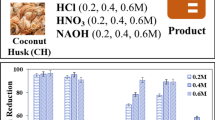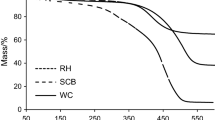Abstract
Organic matter derived from living, or recently living plant and animal, which can be used as fuel is called as biomass. It includes wood and agricultural waste such as dead plant etc. In India, majority of population depends largely upon agriculture as their primary source of income. Following every harvest, a huge amount of biomass is generated. It is mostly discarded as “agro waste”; however, recently, several uses of biomass and its derivatives have been reported. Thermochemical processing of biomass in absence of oxygen produces biomass char and flue gases which are of economic importance. However, it is necessary to characterize the physical and chemical properties of these components so as to utilize their potential benefit to the fullest. In this study, six different biomass remains that include mustard plant, groundnut plant, cotton plant, wheat plant, pigeon peas, and groundnut shell were pyrolyzed at 650 °C, in vertical downdraft fixed-bed biomass reactor. The flue gases were characterized in detail by gas chromatography. X-ray fluorescence, proximate, and ultimate analyses were performed on all BMC (biomass char) samples, and properties such as porosity, particle density, bulk density, point of zero charge, surface pH, surface charges, water-absorption capacity, and BET surface area were determined. SEM and FTIR were also carried out on all BMC samples. Our results showed that the surface area of biomass char varies from 38 to 138 m2/g. The solution pH for all BMC exceeds 8.6, thus confirmed the alkaline nature. Comparison between combustion products produced in the presence (biomass ash) and absence of oxygen (biomass char) is presented. BMC finds applications in agriculture, soil neutralizer, adsorbent, and soil additive. They have high amount of carbon and can act as a rich carbon source for the soil. Flue gases released contain methane and hydrogen which can also improve economic value for the char formation process.




Similar content being viewed by others
References
Abbasi T, Abbasi S (2010) Biomass energy and the environmental impacts associated with its production and utilization. Renew Sustain Energy Rev 14:919–937
Aston WT (1994) Antimicrobial air filter and method of making same. U.S. Patent 5,288,298 esses, and Functions. European Commission: Institute for Environment and Sustainability
Balat H, Kırtay E (2010) Hydrogen from biomass–present scenario and future prospects. Int J Hydrog Energy 35:7416–7426
Batra VS, Urbonaite S, Svensson G (2008) Characterization of unburned carbon in bagasse fly ash. Fuel 87:2972–2976
Brewer CE, Schmidt-Rohr K, Satrio JA, Brown RC (2009) Characterization of biochar from fast pyrolysis and gasification systems. Environ Prog Sustain Energy 28:386–396
Cuenca J, Rodríguez J, Martín-Morales M, S-RZ MZ (2013) Effects of olive residue biomass fly ash as filler in self-compacting concrete. Constr Build Mater 40:702–709
Demeyer A, Nkana JCV, Verloo MG (2001) Characteristics of wood ash and influence on soil properties and nutrient uptake: an overview. Bioresour Technol 77:287–295
FFTC (2001) Application of rice husk charcoal. Food and fertilizer technology center for the Asian and Pacific Region
Gamelas JA, Lourenço AF, Xavier M, Ferreira PJ (2014) Modification of precipitated calcium carbonate with cellulose esters and use as filler in papermaking. Chem Eng Res Des 92:2425–2430
Jatav HS, Jayant H, Kumar S, Kumar V, chattopadhya A, Dhawal S, Singh Y (2017) Role of biochar: in agriculture sector its implication and perspective. Int J Chem Stud 5:14–18
Khonde R, Chaurasia A (2016) Rice husk gasification in a two-stage fixed-bed gasifier: production of hydrogen rich syngas and kinetics. Int J Hydrog Energy 41:8793–8802
Khonde RD, Chaurasia AS (2015) Pyrolysis of sawdust, rice husk and sugarcane bagasse: kinetic modeling and estimation of kinetic parameters using different optimization tools. J Inst Eng (India) Series E 96:23–30
Lehmann J, Rillig MC, Thies J, Masiello CA, Hockaday WC, Crowley D (2011) Biochar effects on soil biota-a review. Soil Biol Biochem 43:1812–1836
Muntohar AS (2004) Utilization of uncontrolled burnt rice husk ash in soil improvement. Civil Engineering Dimension 4, 100 4(2):100–105.
Nkana JCV, Demeyer A, Verloo MG (1998) Chemical effects of wood ash on plant growth in tropical acid soils. Bioresour Technol 63:251–260
Pavia DL, Lampman GM, Kriz GS, Vyvyan JR (2008): Introduction to spectroscopy fourth ed. Brooks Cole Cengage Learning USA, 46–48
Schmidt H-P (December 29 (2012) 55 uses of biochar Journal for ecology, winegrowing and climate farming
Tan X, Liu Y, Zeng G, Wang X, Hu X, Gu Y, Yang Z (2015) Application of biochar for the removal of pollutants from aqueous solutions. Chemosphere 125, 70–85
Trivedi NS, Mandavgane SA, Mehetre S, Kulkarni BD (2016) Characterization and valorization of biomass ashes. Environ Sci Pollut Res:1–14
Umamaheswaran K, Batra VS (2008) Physico-chemical characterisation of Indian biomass ashes. Fuel 87:628–638
UNFAO (2013): United Nations Food and Agriculture Organization (FAO)
Vassilev SV, Baxter D, Andersen LK, Vassileva CG (2013) An overview of the composition and application of biomass ash. Part 1. Phase–mineral and chemical composition and classification. Fuel 105, 40–76
Verheijen F, Jeffery S, Bastos AC, Velde Mvd, Diafas IB (2010) Application to Soils: A Critical Scientific Review of Effects on Soil Properties, Processes, and Functions. European Commission: Institute for Environment and Sustainability
Werther J, Saenger M, Hartge E-U, Ogada T, Siagi Z (2000) Combustion of agricultural residues. Prog Energ Combust 26:1–27
Zhang F-S, Yamasaki S, Nanzyo M (2002) Waste ashes for use in agricultural production: I. Liming effect, contents of plant nutrients and chemical characteristics of some metals. Sci Total Environ 284:215–225
Zhang Q, Wang Y, Wu Y, Wang X, Du Z, Liu X, Song J (2013) Effects of biochar amendment on soil thermal conductivity, reflectance, and temperature. Soil Science Society of America Journal 77, 1478–1487
Zhao R, Coles N, Kong Z, Wu J (2015) Effects of aged and fresh biochars on soil acidity under different incubation conditions. Soil Tillage Res 146:133–138
Acknowledgments
Authors are thankful to IBM, and Department of Metallurgy, VNIT, Nagpur, for their characterization facilities.
Funding
The authors are thankful to the Science and Engineering Research Board, India, for providing research grant (grant no. SB/S3/CE/077/2013) to undertake the work.
Author information
Authors and Affiliations
Corresponding author
Additional information
Responsible editor: Philippe Garrigues
Rights and permissions
About this article
Cite this article
Trivedi, N.S., Mandavgane, S.A. & Chaurasia, A. Characterization and valorization of biomass char: a comparison with biomass ash. Environ Sci Pollut Res 25, 3458–3467 (2018). https://doi.org/10.1007/s11356-017-0689-4
Received:
Accepted:
Published:
Issue Date:
DOI: https://doi.org/10.1007/s11356-017-0689-4




